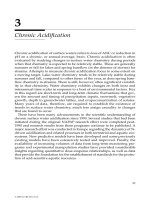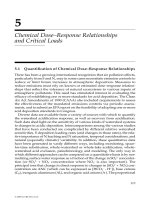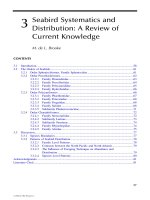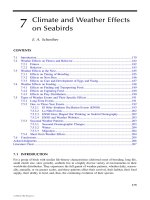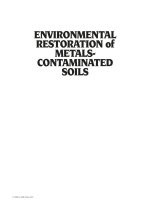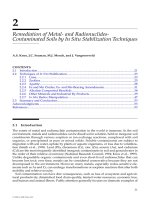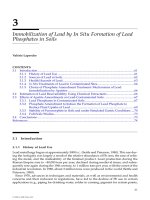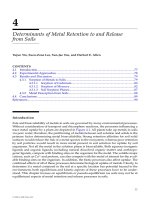ENVIRONMENTAL RESTORATION of METALSCONTAMINATED SOILS - CHAPTER 3 pdf
Bạn đang xem bản rút gọn của tài liệu. Xem và tải ngay bản đầy đủ của tài liệu tại đây (495.63 KB, 16 trang )
61
3
Immobilization of Lead by In Situ Formation of Lead
Phosphates in Soils
Valérie Laperche
CONTENTS
3.1 Introduction 61
3.1.1 History of Lead Use 61
3.1.2 Sources of Lead in Soils 62
3.1.3 Health Hazards of Lead 63
3.1.4
In Situ
Treatments of Lead in Contaminated Sites 64
3.1.5 Choice of Phosphate Amendment Treatment: Mechanisms of Lead
Immobilization by Apatites 64
3.2 Estimation of Lead Bioavailability Using Chemical Extractants 66
3.3 Effects of Apatite Amendments on Lead-Contaminated Soils 67
3.3.1 Lead Phosphates in Contaminated Soils 67
3.3.2 Phosphate Amendment to Induce the Formation of Lead Phosphate to
Reduce Plant Uptake of Lead 69
3.3.3 Stability of Pyromorphite in Soils and under Simulated Gastric Conditions 70
3.3.4 Full-Scale Studies 73
3.4 Conclusions 73
References 74
3.1 Introduction
3.1.1 History of Lead Use
Lead metallurgy began at approximately 5000
B
.
C
. (Settle and Paterson, 1980). This use dur-
ing the Antiquity was largely a result of the relative abundance of Pb ores, the ease of refin-
ing the metal, and the malleability of the finished product. Lead production during the
Roman Empire rose to ~80,000 tons per year, declined during medieval times, and subse-
quently rose again during the 19th century, to 1 million tons per year, with the onset of the
industrial revolution. In 1980, about 3 million tons were produced in the world (Settle and
Paterson, 1980).
Since 1970, advances in techniques and materials, as well as environmental and health
concerns and their inclusion in regulations, have led to the decline of Pb use in certain
applications (e.g., piping for drinking water, solder in canning, pigment for certain paints,
4131C03/frame Page 61 Friday, July 21, 2000 4:58 PM
© 2001 by CRC Press LLC
62
Environmental Restoration of Metals–Contaminated Soils
additives for gases, sheaths for cables, and pesticides). For example, the use of lead in res-
idential paints was not phased out in the United States until the late 1960s and early 1970s;
however, Pb-based paints are used in the United States today. Lead in gasoline was elimi-
nated in 1991 only. Lead arsenate (PbAsHO
4
) also has been banned for use as a pesticide.
Today in France, Pb is mainly used in batteries and storage cells (64%), pigments and sta-
bilizers (10%), pipes and sheets (7%), sheathing (6%), lead shot and fishing sinkers (3%),
gasoline (3%), alloys (3%), and glassware and others (4%). North America accounts for 26%
of world Pb consumption. The world consumption of lead has increased by nearly 25% in
the past two decades. This growth is especially pronounced in Asia and primarily takes
place in the battery sector. This is due to the low cost of lead acid batteries for automobiles
and the lack of a commercially viable substitute. It is not anticipated that this will diminish
in the near future.
3.1.2 Sources of Lead in Soils
Lead is present in uncontaminated soils at concentrations < 20 mg/kg (Davies, 1995), but
higher concentrations have been reported (Holmgren et al., 1993). Colbourn and Thornton
(1978) reported that lead concentration, apparently in uncontaminated UK soils, ranges
from 10 to 150 mg/kg. In polluted areas, concentrations of 100 to 1000 times that of the nor-
mal level can be found (Davies, 1995; Adriano, 1986; Peterson, 1978). Sites of this type are
common in soils contaminated by petroleum and paint residues, particulate lead from shot
at private and military rifle ranges, lead batteries at dump sites, tailings from the mining of
lead ores, and soils in orchards and vineyards in which PbAsHO
4
was applied. Additionally,
other industrial activities can result in lead pollution, some of which are listed in Table 3.1.
Much of the lead in urban soils is thought to have been derived from vehicle exhausts
as well as abraded tire material. Soils in close proximity to building walls and foundations
can also contain lead from leached and/or exfoliated paints. This multiplicity of potential
contamination sources results in a wide range of lead concentrations in urban soils, with
values in some instances approaching those found in sites adjacent to mining and smelting
activities.
In agricultural soils the repeated application of sludge and pesticides can increase con-
centrations of soil Pb. Page (1974) reported that the lead in sewage sludge ranged from 100
to 1000 mg/kg, but now the lead concentrations in sewage sludge are lower and range from
200 to 500 mg/kg (Epstein et al., 1992). Chaney and Ryan (1994) suggested a limited high
TABLE 3.1
Identification of Lead Oxides, Salts and Organic, and Their Uses in Industry
Lead Compound Application
Litharge (PbO)
Minium (Pb
3
O
4
)
Composition of the paste used to fill the cells of battery plates, and
minium is also used to protect iron and steel from corrosion
Lead naphthenate and octonate Drying agents for oil paints and alkyd (glyceryl phthalate) paints
Crocoite (PbCrO
4
) Colored pigments (from yellow to red)
Wufenite (PbMoO
4
)
“Lead sulfate” (2PbSO
4
.
PbO) White based pigments
“Lead carbonate” (2PbCO
3
.
Pb(OH)
2
) Pesticides
Lead stearate Stabilizers for plastics
Lead arsenate (PbHAsO
4
) Pesticides
Organic salts Lubricants
Tetramethyl (Pb(CH
3
)
4
) Additives for gasoline as anti-shocks
Tetraethyl (Pb(C
2
H
5
)
4
)
4131C03/frame Page 62 Friday, July 21, 2000 4:58 PM
© 2001 by CRC Press LLC
Immobilization of Lead by In Situ Formation of Lead Phosphates in Soils
63
lead concentration for sludge at 300 mg/kg. For some sludges there will need to be an
improvement to permit their marketing.
Another situation where lead contamination can occur is in land heavily used for clay
pigeon shooting. Where millions of cartridges are fired each year, soils can accumulate sev-
eral grams of lead per kilogram (Rooney et al., 1997).
In mining and smelting sites, lead concentrations can reach extremely high levels such as
30 g/kg next to an old smelter (Colbourn and Thornton, 1978). This type of pollution is usu-
ally referred to as “historical pollution” as it is related to past activities of lead production
and processing plants at a time (nineteenth century) when operating techniques and
knowledge of the problems linked to lead pollution were not what they are today.
Whereas these levels of lead pollution are large, they are generally restricted in geo-
graphic extent and may not represent a mobile form of lead.
3.1.3 Health Hazards of Lead
Numerous human health problems are associated with exposure to Pb. The effects of Pb
poisoning occur when Pb is present in the bloodstream. This is typically the result of inges-
tion and/or inhalation of Pb-containing dust, particulates, fluids, or fumes. In 1979, the
effect on neurologic development and IQ was found (Needleman et al., 1979). Other health
effects can occur at lower levels (US-DHEW, 1991). The Centers for Disease Control (CDC,
1991) recommended that the blood lead level of concern from the standpoint of protecting
the health of sensitive populations was to 10
µ
g/dl whole blood.
The greatest contributors to human exposure to lead are lead-based paints, urban soils
and dust (Chaney and Ryan, 1994), and in isolated cases, drinking water (Adriano, 1986).
Lead rarely occurs naturally in drinking water. Instead, lead contamination usually orig-
inates from some point in residential and industrial water delivery systems. It is most com-
monly caused by the corrosion of lead service connections, pipes, or lead solder used to join
copper pipes in municipal water systems and private residences. In 1986, Pb was banned
from use in pipes and solder in public water systems within the United States. In 1991, the
U.S. EPA set a new nationwide standard of 15
µ
g/L for Pb in drinking water.
Young children are considered to be at the highest risk of getting lead poisoning. Before
1978, lead was used profusely in interior and exterior paints. Children can ingest paint
chips and become exposed to lead. Also, lead paint over time turns to dust and falls to the
floor within structures or onto soil surrounding building exteriors. In residential settings,
this dust can be tracked into or around the house and crawling children become exposed
through hand-to-mouth action or inhalation of lead-based dust. Paint lead, soil lead, and
exterior dust lead influence the concentration of lead in house dust. The house dust lead
impacts the amount of lead present on a child’s hands. The house dust lead and hand lead
can be directly correlated with blood levels (Clark et al., 1991). Research by Charney et al.
(1983) elucidated the key role that house dust plays in influencing blood lead values. This
study compared blood lead concentrations of children from families that did not control
household dust (control group) and children from families that control household dust
(experimental group). The household dust was controlled by wet-mopping twice monthly
(two or three times per week for the “hot spots”), washing children’s hands prior to con-
suming meals and being put in bed, as well as restricting access to areas of high lead levels.
During the study year, the children in the control group did not show any significant
change in blood lead levels; in contrast, there was a significant fall in the mean blood lead
level in the experimental group after 1 year (from 38.6 to 31.7
µ
g/L).
Another potential problem associated with contaminated urban soils is their use in veg-
etable gardens without knowledge that trace elements can be taken up by plants and
4131C03/frame Page 63 Friday, July 21, 2000 4:58 PM
© 2001 by CRC Press LLC
64
Environmental Restoration of Metals–Contaminated Soils
transferred to the food chain. While Pb contamination in urban soils is quite variable, the
occurrence of concentrations comparable to those found in mining and smelting environ-
ments is of great concern. Preer et al. (1984) reported a lead range from 44 to 5300 mg Pb/kg
of soil in gardens in Washington, D.C. Sterrett et al. (1996) studied lead accumulation by
lettuce grown in contaminated urban soils (392 to 5210 mg/kg) and found significant
increases in lettuce leaf lead concentration compared to the control soil. Lead uptake by let-
tuce was not significantly higher than the control unless lead levels in the soil exceeded
500 mg/kg soil. In the latter case, lead levels in lettuce reached 37 mg Pb/kg dry matter.
However, extensive uptake studies and comparative risk evaluations suggest that the
greatest risk for human exposure to lead in urban soils comes from direct particulate inges-
tion and not food chain transfer (Chaney and Ryan, 1994; Chaney et al., 1989).
The OSWER (Office of Solid Waste and Emergency Response) guidance sets a residential
screening level of soil Pb at 40 mg/kg; in the range 400 to 5000 mg/kg, limited interim con-
trols are recommended depending on conditions at the sites, and soil remediation is recom-
mended above 5000 mg/kg (U.S. EPA, 1994).
As a result of widespread lead contamination in soil, considerable attention and
resources are being focused on remediating lead-contaminated sites.
3.1.4
In Situ
Treatments of Lead in Contaminated Sites
In general, lead accumulates in the topsoil, usually within the top few centimeters (Swaine
and Mitchell, 1960), but may also migrate to deeper layers in some cases (Fisenne et al.,
1978; Kotuby-Amacher et al., 1992). The development of
in situ
remediation treatments that
can be used to reduce Pb bioavailability and transport in soils is desirable.
As described by the Environmental Protection Agency (U.S. EPA, 1990):
An
in situ
treatment technology is defined as one that can be applied to treat the hazard-
ous constituents of a waste or contaminated environmental medium where they are locat-
ed and its capability of reducing the risk posed by these contaminants to an acceptable
level or completely eliminating that risk.
In situ
treatment implies that the waste materials
are treated without being physically removed from the ground.
For inorganic contaminants, the treatments generally applied include soil flushing, solid-
ification/stabilization (pozzolan Portland cement, lime fly ash pozzolan, thermoplastic
encapsulation, sorption, vitrification), and chemical and physical separation techniques
(permeable barriers, electrokinetics).
The mechanism of
in situ
treatments may be physical, chemical, thermal, biological, or a
combination of these. The choice of remediation treatment depends mostly on the type of
pollution, the soil properties, and the level of effectiveness desired. Also, amendments
should be easily available, relatively low in cost, easy to apply and incorporate, benign to
the people using them, and not cause further environmental degradation.
3.1.5 Choice of Phosphate Amendment Treatment: Mechanisms of Lead Immobilization
by Apatites
In 1990, Ohio State University and U.S. EPA researchers began an effort to develop a suit-
able
in situ
treatment technology for lead-contaminated sites with the following objectives:
• To transform all “labile” phases of lead in a chemical form that would not be
released under normal environmental weathering conditions
4131C03/frame Page 64 Friday, July 21, 2000 4:58 PM
© 2001 by CRC Press LLC
Immobilization of Lead by In Situ Formation of Lead Phosphates in Soils
65
• To use inexpensive, readily available, easy-to-manipulate, nontoxic reagents
• To identify a process that could work for a wide range of lead sources (soil,
waste, water treatment)
An examination of existing chemical and geochemical knowledge about lead in the envi-
ronment suggested that lead phosphates were among the most stable lead compounds in
nature, especially under acidic conditions, at surficial temperatures and pressures. In cal-
careous soils, the solubility of lead is regulated by lead carbonate (PbCO
3
). In noncalcare-
ous soils, the solubility of lead appears to be regulated by Pb(OH)
2
, Pb
3
(PO
4
)
2
, Pb
4
O(PO
4
)
2
,
or Pb
10
(PO
4
)
6
(OH)
2
, depending on the pH (Santillan-Medrano and Jurinak, 1975). These
results tend to agree with Nriagu’s suggestion (1972, 1973) that lead phosphate formation
could serve as a significant sink for lead in the environment.
An obvious choice of a phosphate reagent to test for lead treatment was commercial fertil-
izers that contain phosphate, commonly known as triple superphosphate (produce by react-
ing phosphoric acid with phosphate rock). This source of phosphate reagent was considered
unsuitable because of its relatively high cost, its high water solubility (phosphate in surface
waters causes eutrophication, the excessive growth of algae), and its reaction in water
producing very acidic phosphoric acid. The latter can actually cause lead to mobilize and
would counteract any immobilization effects of the added phosphate (Sterrett et al., 1996).
Ma et al. (1993, 1994a, and 1994b) used a less acid-forming calcium phosphate, hydroxyl-
apatite (Ca
10
(PO
4
)
6
(OH)
2
), which is essentially the same mineral contained in bones, and
phosphate rock, primarily fluorapatite (Ca
10
(PO
4
)
6
F
2
), a very insoluble calcium phosphate.
Hydroxylapatite can be acquired commercially in pure form, but commercial use of the
technology, if successful, would have to be based on phosphate rock (phosphate rock is
cheaper than hydroxylapatite) or bone meal. The principal commercial deposits of phos-
phate rocks in the United States exist in Florida, North Carolina, and Idaho, and to a lesser
degree in Montana and Utah. Prices for phosphate in Idaho, Montana, and Utah averaged
$17.5/tonne, and in Florida and North Carolina $26.1/tonne (Gurr, 1995). Phosphate rock
has long been used as a fertilizer (mostly by organic farmers) since, if finely ground, phos-
phate rock will partially dissolve in the soil for uptake by plants.
Preliminary research by the Ohio State University and U.S. EPA researchers (Ma et al.,
1993, 1994a, and 1994b) showed that lead could be precipitated instantaneously from solu-
tion by apatite (hydroxylapatite, fluorapatite, or chlorapatite) and that the solid formed
was pyromorphite (hydroxypyromorphite, fluoropyromorphite, or chloropyromorphite).
Ca
10
(PO
4
)
6
X
2
(s) + 6H
+
(aq)
⇒
10Ca
2+
(aq) + 6HPO
4
2+
(aq) + 2X
–
(aq) (1)
10Pb
2+
(aq) + 6HPO
4
2+
(aq) + 2X
–
(aq)
⇒
Pb
10
(PO
4
)
6
X
2
(s) + 6H
+
(aq) (2)
with X = OH, F, or Cl.
A very important finding of this early work was that pyromorphite could easily be distin-
guished from apatite by X-ray diffraction (XRD) and by scanning electron microscopy (SEM).
Hydroxylapatite is composed of large rectangular crystals, while hydroxypyromorphite
exists as needles (Figure 3.1). The ability to identify the mineral forms of the immobilized
lead allows one to predict the long-term stability of immobilized lead in the environment.
Ma et al. (1994a) showed that apatite could also be sorbed by other metals (Al, Fe, Cu, Cd,
Ni, and Zn), but less effectively than lead. The mechanism of immobilization for these met-
als was not identified, but it can be adsorption or precipitation (Xu et al., 1994). Another
study by Ma et al. (1994b) showed that anions (nitrate, sulfate, and carbonate) had minimal
effect on the amount of aqueous lead immobilized at low concentrations.
4131C03/frame Page 65 Friday, July 21, 2000 4:58 PM
© 2001 by CRC Press LLC
66
Environmental Restoration of Metals–Contaminated Soils
Zhang et al. (1997) showed that lead sorbed on the surface of oxides (e.g., goethite) was
rapidly desorbed in the presence of NaH
2
PO
4
to precipitate as chloropyromorphite. By con-
trast, when hydroxylapatite was used instead of NaH
2
PO
4
, the formation of chloropyro-
morphite was slower and appeared to be controlled by the rate of dissolution of the
hydroxylapatite.
Nevertheless, the effectiveness of lead removal from solution or desorbed from solids
resulted in the formation of pyromorphite in equilibrium with an aqueous lead concentra-
tion equal to or below the drinking water limits proscribed by U.S. EPA (15
µ
g/L).
3.2 Estimation of Lead Bioavailability Using Chemical Extractants
It is known that the total amount of trace elements in soil is an overestimation of the real
danger they actually represent. The transfer of trace elements through soil profiles to aqui-
fers or their uptake by plants is related to their physicochemical forms in soil, their mobility,
and their bioavailability (Colbourn and Thornton, 1978). Understanding lead mobility and
bioavailability in contaminated soils is important for evaluating the potential environmen-
tal effects of lead.
Lead compounds entering soil become partitioned among several soil compartments:
soil solution, exchangeable, adsorbed, or complexed by organic or inorganic compounds,
oxides and carbonates, and primary minerals. Only a small portion of the lead in soil is
FIGURE 3.1
SEM micrograph of hydroxylapatite (Bio-Rad Laboratory, Rochester, NY) reacted with lead nitrate at pH 5 for 2 h.
Hydroxylapatite is composed of large rectangular crystals while hydroxypyromorphite exists as needles.
(Micrograph courtesy of John Mitchell, MARC, Geology Department, OSU.)
4131C03/frame Page 66 Friday, July 21, 2000 4:58 PM
© 2001 by CRC Press LLC
Immobilization of Lead by In Situ Formation of Lead Phosphates in Soils
67
available for plant uptake. All but the most insoluble surface and solid-phase species are
thought to be phytoavailable.
Extractable lead is generally used as the indicator of amount available for plant uptake.
Various chemical extractants (single and sequential) have been used to assess bioavailabil-
ity of lead (Tessier et al., 1979; Mench et al., 1994; Berti and Cunningham, 1997). Prediction
of lead availability seems to depend on several factors, such as the type of extractant, the
molarity of the extractants, soil properties (such as pH), as well as the actual forms of lead
present within a given sample.
Despite the difficulties to find the “perfect extraction method” for measurement of the
bioavailability of trace elements in soil, these procedures (Tessier et al., 1979; Mench et al.,
1994; Berti and Cunningham, 1997) provide indirect information on the reactivity of the
trace elements and their potential mobility, in particular about the residual fraction (nonex-
tractable). The residual fraction should contain mainly primary and secondary minerals
which may have trace elements within crystal structure. These trace elements are not
expected to be released into solution over a reasonable period of time under normal weath-
ering conditions.
Ma and Rao (1997) studied the effects of phosphate rock on sequential chemical extrac-
tion of lead in different contaminated soils using the procedure developed by Tessier et al.
(1979). Sequential extraction was used to determine the lead distribution in the soil and
evaluate the effectiveness of using phosphate rock to immobilize lead in soil. They showed
that most of the lead in the soils was concentrated in the potential available fractions (79 to
96%), sum of the water soluble, exchangeable, carbonate-bound, Fe-Mn oxides-bound and
organic bound fractions. The presence of phosphate rock reduced the extractable lead, and
the percentage of lead reduction ranged from 10 to 96% (Table 3.2). The effectiveness of
phosphate rock treatments in converting lead from available to an unavailable fraction was
greater with increasing amounts of phosphate rock added to the soil. Lead precipitation as
fluoropyromorphite (Pb
10
(PO
4
)
6
F
2
) was suggested as the reason for reducing lead solubility
(Ma and Rao, 1997).
The determination of nonresidual and residual fractions can be the first step in evaluating
the real risk of the presence of lead in contaminated soil.
3.3 Effects of Apatite Amendments on Lead-Contaminated Soils
3.3.1 Lead Phosphates in Contaminated Soils
Lead phosphates form naturally in contaminated soils (Cotter-Howells and Thornton,
1991; Cotter-Howells et al., 1994; Ruby et al., 1994). In a historic lead mining village in the
U.K., Cotter-Howells and Thornton (1991) identified substantial amounts of lead chloro-
phosphate in the topsoil (0 to 5 cm). In a more recent study, Cotter-Howells et al. (1994)
determined the composition of the lead phosphate as a calcium-rich pyromorphite with
27% of the lead replaced by calcium.
Ruby et al. (1994) showed that the formation of lead phosphate can occur naturally in a
short period of time (less than 13 years) in a soil contaminated by smelting activities when
phosphorus is not a limited factor. In this site, the phosphorus content ranged from 1400 to
17,700 mg/kg, considerably above the average phosphorus content in the United States
(between 200 to 5000 mg/kg; Lindsay, 1979).
4131C03/frame Page 67 Friday, July 21, 2000 4:58 PM
© 2001 by CRC Press LLC
68
Environmental Restoration of Metals–Contaminated Soils
TABLE 3.2
Lead Distribution in Eight Contaminated Soils in the Presence of Different Amounts of OC Phosphate Rock (OCPR)
Burch, Washington (PbAsHO
4
)
East Field 1, Montana (smelter)
OCPR added (g) 0 01.25 0.25 0 0.125 –.25
Residual Pb, % 13 56 73 12 32 57
Nonresidual Pb, % 87 44 27 88 68 42
Decrease in nonresidual Pb, % 50 69 23 52
Sum of all fractions 2,920 ± 58 2,850 ± 44 2,660 ± 87 6,310 ± 190 6,190 ± 421 6,380 ± 438
Total via single digestion 2,680 ± 80
5,970 ± 226
BPS, Pennsylvania (Battery breaking site)
PTC, Oklahoma (smelter)
OCPR added (g) 0 0.125 0.25 0 0.125 0.25
Residual Pb, % 8 18 32 9 83 95
Nonresidual Pb, % 92 82 68 91 17 5
Decrease in nonresidual Pb, % 10 26 82 95
Sum of all fractions 41,100 ± 669 47,700 ± 1050 37,900 ± 730 662 ± 37 847 ± 72 736 ± 66
Total via single digestion 40,100 ± 800
1,300 ± 85
Twin, Washington
(PbAsHO
4
)
East Field 2, Montana
(smelter)
AEC 1-1, Connecticut
(incineration ash)
Area 40, Washington
(building demolition)
OCPR added (g) 0 0.125 0 0.125 0 0.125 0 0.125
Residual Pb, % 4 96 6 43 4 20 21 66
Nonresidual PB, % 96 4 94 57 96 78 79 35
Decrease in nonresidual Pb, % 96 40 19 56
Sum of all fractions 768 ± 48 874 ± 62 4,920 ± 170 2,985 ± 310 10,600 ± 790 9,550 ± 740 8,330 ± 550 7,800 ± 474
Total via single digestion 705 ± 50
4,480 ± 250 12,500 ± 710 7,640 ± 510
Ma, Q.Y. and G.N. Rao, Effects of phosphate rocks on sequential chemical extraction of lead in contaminated soils,
J. Environ. Qual.
, 26, 788, 1997.
Note:
Explanation of the abbreviation used in the table — first the abbreviation, second the name of the soil, third the location, and fourth the source of
the contamination: BU: Burch, Washington (PbAsHO
4
); EF1: East Field 1, Montana (smelter); BP: BPS, Pennsylvania (Battery br
eaking site); PT: PTC,
Oklahoma (smelter); TW: Twin, Washington (PbAsHO
4
); EF2: East Field 2, Montana (smelter); DA: AEC 1-1, Connecticut (incineration ash); DU:
Area 40,
Washington (building demolition).
4131C03/frame Page 68 Friday, July 21, 2000 4:58 PM
© 2001 by CRC Press LLC
Immobilization of Lead by In Situ Formation of Lead Phosphates in Soils
69
The formation of lead phosphates in nature is difficult to predict. Pyromorphite precip-
itates from aqueous solution and lead immobilization is near completion in less than
30 min for a range of pH from 3 to 7 (Ma et al., 1993). Also, Laperche et al. (1996) provided
direct physical evidence of the formation of pyromorphite after a few days at pH 5, sub-
sequent to amendment of an enriched soil fraction with synthetic hydroxylapatite; how-
ever, in natural field settings, mineral formation rates are likely to be slower than in
laboratory experiments.
Ruby et al. (1994) demonstrated that the weathering of galena (PbS) to anglesite (PbSO
4
)
followed by alteration to insoluble lead phosphate in soil is due to the presence of adequate
phosphate content. Forty-six percent of the original galena had been altered to lead phos-
phates under uncontrolled environmental conditions. Ruby et al. (1994) suggested that the
rate of transformation from galena to pyromorphite could be increased by optimizing con-
ditions such as phosphate and chlorine reactivities, pH, water content, and mixing.
3.3.2 Phosphate Amendment to Induce the Formation of Lead Phosphate to Reduce
Plant Uptake of Lead
Different types of phosphates have been used to induce the formation of lead phosphates:
NPK fertilizers, Ca(H
2
PO
4
)
2
(Sterrett et al., 1996), Na
2
HPO
4
(Cotter-Howells and Caporn,
1996), and apatite (Laperche et al., 1997; Chlopecka and Adriano, 1997a and b). Cotter-
Howells and Caporn (1996) also used peat as phosphate amendment and showed that root
exudates containing phosphate enzymes could convert organic-P to phosphate.
Some of the phosphate amendments are more effective than others in reducing plant
uptake of lead. Application of NPK fertilizer alone or with Ca(H
2
PO
4
)
2
showed little or no
effect on lead uptake (Sterrett et al., 1996). Sterrett et al. (1996) suggested that the phosphate
treatment gave higher metal concentrations in plant tissues probably because of the soil
acidification due to the application of the acidic phosphate fertilizer salt.
In the case of the apatite amendment, the pH of the treated soils increased from 0.3 to
0.9 units compared to the untreated soils as a function of the quantity of apatite added to
the soils (Chlopecka and Adriano, 1997a). In all cases (Laperche et al., 1997; Chlopecka and
Adriano, 1997a and b), apatite amendments reduced lead uptake as a function of the quan-
tity of apatite added to the contaminated soil: 15 to 60% and 12 to 41% in maize and barley
tissues, respectively (Chlopecka and Adriano, 1997b), and 45 to 87% in sudax grass shoots
for different contaminated soils (Laperche et al., 1997). Laperche et al. (1997) studied the
effect of synthetic and natural apatite (phosphate rock) on lead uptake for a soil contami-
nated by smelting activities: soil A from Butte, Montana (2400 mg Pb/kg) and a soil heavily
contaminated by paint; soil B from Oakland, California (37,000 mg Pb/kg). The quantities
of phosphate materials added were calculated as a function of the lead content of the soil
corresponding at 0.33 (treatment 1) and 1.50 (treatment 4) times the mass of phosphate
material necessary for stoichiometric conversion (on a molar basis) of all of the soil lead to
pyromorphite. The same production of shoot tissue was measured in both soils even
though the lead content of the plants grown on soil B (106 mg Pb/kg of dried shoot) was
much higher than that of the plants grown on soil A (6.7 mg Pb/kg of dried shoot). In both
soils, Pb uptake by shoots in phosphate-treated soils decreased compared to the untreated
soils (Figure 3.2). The greatest reduction of lead uptake was obtained with the largest quan-
tity of apatite amendment. In all treatments, lead showed greater accumulations in root tis-
sues than in shoot tissues. Chlopecka and Adriano (1997a) showed similar results of apatite
treatments on Pb uptake by maize in four different contaminated soils. Laperche et al.
(1997) showed that, in the presence of a large quantity of phosphate, lead accumulated in
root tissues more than in an untreated contaminated soil. Previous research has suggested
4131C03/frame Page 69 Friday, July 21, 2000 4:58 PM
© 2001 by CRC Press LLC
70
Environmental Restoration of Metals–Contaminated Soils
that some plants use an exclusion mechanism to accumulate lead in roots and limit trans
-
port to shoots. Koeppe (1977) found that lead precipitated on root cell walls in an insoluble,
amorphous form which, in maize, has been identified as a lead phosphate.
After only 4 months of incubation, lead phosphate particles were found on the surface of
the roots but no lead phosphate particle was identified by X-ray diffraction in the bulk soil.
Cotter-Howells et al. (1994) showed that EXAFS (Extended X-ray Absorption Fine Struc-
ture) might be more suitable than X-ray diffraction for the identification of compounds at
low abundance. Cotter-Howells et al. (1994) identified by EXAFS in a mine waste soil
“calcium-rich pyromorphite.” Cotter-Howells and Caporn (1996) showed that it is still pos-
sible to find and to identify by X-ray diffraction the calcium-rich pyromorphite, but after
concentration of the heavy fraction by high-density separation (Figure 3.3).
3.3.3 Stability of Pyromorphite in Soils and under Simulated Gastric Conditions
Laperche et al. (1997) showed that when hydroxypyromorphite is the only source of phos-
phate, sudax grass can induce its dissolution (Figure 3.4). In the presence of hydroxypyro-
morphite and apatite, the lead content in shoots decreased an average 10 to 100 times as
function of the quantity of apatite and the type of apatite used. A fine ground phosphate
rock (<250
µ
m) was more efficient than unground phosphate rock (2 to 0.5 mm). At a
hydroxypyromorphite/apatite ratio of 0.5, fine ground phosphate rock had the same effi-
ciency as synthetic hydroxylapatite. Thus it is likely that the dissolution rates of both
FIGURE 3.2
Shoot (average of three cuts) and root lead concentration in soils A and B. A: untreated soil; B: phosphate rock
treatment (0.33); C: hydroxylapatite treatment (0.33); D: phosphate rock treatment (1.50); E: hydroxylapatite
treatment (1.50).
Soil A shoot Soil A root
Soil B root
Soil B shoot
mg Pb/kg dried grass in Soil A experiment
mg Pb/kg dried grass in Soil B experiment
Soil A
A
D
E
A
D
E
B
C
10
8
6
4
2
0
160
120
80
40
0
Soil B
4131C03/frame Page 70 Wednesday, August 9, 2000 3:14 PM
© 2001 by CRC Press LLC
Immobilization of Lead by In Situ Formation of Lead Phosphates in Soils
71
apatites are greater than that of hydroxypyromorphite and can maintain a sufficient solu-
tion phase concentration of phosphorus to inhibit dissolution of the hydroxypyromorphite
and reduce lead uptake by the sudax grass.
In environmental conditions, chloropyromorphite forms instead of hydroxypyromorphite
(Cotter-Howells and Caporn, 1996; Ruby et al., 1994), and chloropyromorphite has a much
lower solubility than hydroxypyromorphite, log Ksp = –4.14 and –25.05, respectively. It is
likely that plant uptake from chloropyromorphite would be even less than that observed from
hydroxypyromorphite by Laperche et al. (1997). Nevertheless, it seems prudent to maintain an
excess quantity of unreacted phosphate in Pb-contaminated soils, even after pyromorphite
formation has occurred in order to decrease the uptake of pyromorphite-P by plants.
The association of growing plants and using apatite to remediate a contaminated site has
different objectives depending on the use of the plant and the type of polluted sites one is
dealing with. First, having a vegetation cover provides pollution control and stability to the
soil. Wind erosion is prevented and percolation can be highly reduced. Second,
in situ
immobilization for heavily contaminated bare sites (such as some industrial sites or mining
sites) may allow revegetation by plant species with low tolerances for lead. Third, plants
can be used not only for phytostabilization of contaminated sites but for agricultural needs.
Plant-root exudates induce the formation of lead phosphate in soil, but also some plants
can accumulate lead in roots. Apatite applications considerably reduce the lead content in
FIGURE 3.3
Portion of XRD trace showing the prominent peaks of CA-rich pyromorphite (Py) identified in the high-density
fraction of a Derbyshire soil, together with XRD traces of the high-density fraction from the phosphate amended
and control Charterhouse soil. Traces are normalized on barite (Ba), which is present in all three samples. The
presence of peaks at similar 2
Θ
values in the phosphate amended soil, absent in the control soil, suggests the
presence of Ca-rich pyromorphite in this sample. (Source: Cotter-Howells, J.D., P.E. Champness, J.M. Charnock,
and R.A.D. Pattrick, Identification of pyromorphite in mine-waste contaminated soils by ATEM and EXAFS,
Eur. J. Soil Sci.
, 45, 393, 1994; Cotter-Howells, J.D. and S. Caporn, Remediation of contaminated land by formation
of heavy metal phosphates,
Appl. Geochem.
, 11, 335, 1996.)
Py
Ba
Py
Py
500
400
300
200
100
28 29 30 31 32
0
Derbyshire soil
Charterhouse soil -
phosphate amended
Charterhouse soil - control
Py
Count Rate /s
-1
2θ/°
4131C03/frame Page 71 Wednesday, August 9, 2000 3:14 PM
© 2001 by CRC Press LLC
72 Environmental Restoration of Metals–Contaminated Soils
shoot material, perhaps allowing for use of the aboveground biomass for applications that
would be unsuitable if greater tissue concentrations of lead were present. The reuse of con-
taminated soils treated by apatite in forage or crop production may be viable.
The fact that phosphate added to contaminated soil reduced lead uptake by plants will
also reduce food chain contamination, but lead can be involuntarily ingested by livestock
from soil. Livestock can be directly exposed to lead, as children can be exposed to lead dust
or lead soil. A number of studies have examined lead bioavailability from soils. Research-
ers have developed estimations of the impact to blood lead levels based upon elevations in
soil lead values (Bornschein et al., 1986; Clark et al., 1991). Davis et al. (1992) showed that
the geochemical factors that control lead availability (mineralogy, encapsulation, and par-
ticle size) in soil or mining waste controlled the bioavailability of lead in the gastrointesti-
nal tract. Consequently, the blood level response noted in the different environments
reflects the difference in lead availability based on lead geochemistry. An in vitro test to
evaluate the in vivo bioaccessibility of lead in soil and mine waste lead has been developed
FIGURE 3.4
Sudax lead shoot tissue concentrations in a sand experiment. (❍) 12 g of hydroxypyromorphite, (●) 6 g of
hydroxypyromorphite + 2.3 g of hydroxylapatite, (▼) 6 g of hydroxypyromorphite + 4.6 g of hydroxylapatite,
(■) 6 g of hydroxypyromorphite + 3 g of fine ground phosphate rock, (◆) 6 g of hydroxypyromorphite + 6 g of
fine ground phosphate rock, (▲) 6 g of hydroxypyromorphite + 3.5 g of ungrounded phosphate rock.
50.0
40.0
30.0
20.0
10.0
6.0
5.0
4.0
3.0
2.0
0.4
0.2
0.0
22
66
110
154
days
mg Pb/kg dried grass
4131C03/frame Page 72 Wednesday, August 9, 2000 3:14 PM
© 2001 by CRC Press LLC
Immobilization of Lead by In Situ Formation of Lead Phosphates in Soils 73
by Ruby et al. (1992 and 1993). Macklis (1996) used the test developed by Ruby et al. (1993)
to show that the addition of hydroxylapatite decreased lead bioavailability by 8% in a soil
contaminated by mining activities and by 14% in a soil contaminated by paint, after
4 months of incubation.
Another experiment on rats and pigs fed with a diet that was supplemented with lead-
contaminated soil and contaminated soil treated with hydroxylapatite or phosphate rock
showed that lead in blood and bones was reduced in the experiment with the hydroxylap-
atite or phosphate rock treated soil (Logan et al., 1995). Logan et al. (1995) could not
attribute the reduction of lead availability to the formation of insoluble lead phosphate in
the soil or in the gastrointestinal track of the animals.
3.3.4 Full-Scale Studies
Field studies at Joplin, Missouri are being conducted by the U.S. EPA, Missouri Department
of Natural Resources (MDNR), University of Missouri, and the Department of Agriculture-
Agricultural Research Service (USDA-ARS).
Studies involve treatment of contaminated soil with various amendments that may
reduce the bioavailability of lead in soil. The contamination of the site is due to smelting
activities in the early 1900s. Lead concentrations range from 1000 to 5000 mg/kg. One of
the goals of this study is to determine the relative efficacy of various amendments (such as
phosphoric acid, hydroxylapatite, rock phosphate) and application techniques in reducing
the levels of bioavailable lead in soil. These experiments are not complete and the results
have not been published.
More of these full-scale experiments need to be conducted before the use of phosphate
rocks for remediation purposes on contaminated sites can be recommended.
3.4 Conclusions
Methods for remediation of lead-contaminated soils have recently become an important
issue because of the health risks associated with this pollutant. High concentrations of lead
can create serious problems both in agricultural soils and industrial sites and pose a hazard
for men, animals, and plants.
The final choice for the remediation of a contaminated site is a function of the nature and
the degree of the contamination, the redevelopment of the site, and the technical and finan-
cial needs available. Remediation can be achieved by preventing the lead from spreading
to the surroundings and to groundwater. One way to prevent such spreading is to immo-
bilize it in soils, through the addition of amendments such as lime, phosphates, apatites,
aluminosilicates (zeolites, beringite, clays), iron, and manganese materials.
Phosphate, and in particular apatite, has been shown to have great potential for use in in
situ immobilization of lead. Laboratory, greenhouse, in vitro, and in vivo experiments have
demonstrated the effectiveness of apatite in remediating contaminated soils, industrial
sites, and wastes.
In situ immobilization of lead by phosphate rock with revegetation of the contaminated
area can be an efficient, economical, realistic, and cost-effective alternative remediation
method for agricultural soils, kitchen gardens, industrial sites, and so on.
4131C03/frame Page 73 Friday, July 21, 2000 4:58 PM
© 2001 by CRC Press LLC
74 Environmental Restoration of Metals–Contaminated Soils
References
Adriano, D.C., Lead, in Trace Elements in the Terrestrial Environment, Springer-Verlag, New York, 7,
219, 1986.
Berti, W.R., and S.D. Cunningham, In place inactivation of Pb in Pb-contaminated soils, Environ. Sci.
& Technol., 31, 1359, 1997.
Bornschein, R.L., P.A. Succop, K.M. Krafft, C.S. Clark, B. Peace, and P.B. Hammond, Exterior surface
dust lead, interior house dust lead and childhood exposure in an urban environment. Conf.
Trace Substances Environ. Health, 11, 322, 1986.
CDC, Preventing Lead Poisoning in Young Children, U.S. Department of Health and Human Ser-
vices, Atlanta, GA, 1991.
Chaney, R.L., H.W. Mielke, and S.B. Sterrett, Speciation, mobility, and bioavailability of soil lead,
Environ. Geochem. Health, Suppl. 11, 109, 1989.
Chaney, R.L. and J.A. Ryan, Risk Based Standards for Arsenic, Lead and Cadmium in Urban Soils,
Kreysa, G. and J. Wieser, Eds., DECHEMA, Frankfurt, 1994.
Charney, E., B. Kessler, M. Farfel, and D. Jackson, Childhood lead poisoning. N. Engl. J. Med., 309(18),
1089, 1983.
Chlopecka, A. and D.C. Adriano, Inactivation of metals in polluted soils using natural zeolite and
apatite, Abstract 4th Int. Conf. Biogeochemistry of Trace Elements, Berkeley, CA, 1997a, 415.
Chlopecka, A. and D.C. Adriano, Mimicked in-situ stabilization of lead-polluted soils, Abstract 4th
Int. Conf. Biogeochemistry of Trace Elements, Berkeley, CA, 1997b, 423.
Clark, S., R. Bornschein, P. Succop, S. Roda, and B. Peace, Urban lead exposures of children in
Cincinnati, OH, Chem. Speciation Bioavailability, 3(3/4), 163, 1991.
Colbourn, P. and I. Thornton, Lead pollution in agricultural soils, J. Soil Sci., 29, 513, 1978.
Cotter-Howells, J.D. and I. Thornton, Sources and pathways of environmental lead to children in a
Derbyshire mining village, Environ. Geochem. Health, 12, 127, 1991.
Cotter-Howells, J.D., P.E. Champness, J.M. Charnock, and R.A.D. Pattrick, Identification of pyro-
morphite in mine-waste contaminated soils by ATEM and EXAFS, Eur. J. Soil Sci., 45, 393, 1994.
Cotter-Howells, J.D. and S. Caporn, Remediation of contaminated land by formation of heavy metal
phosphates, Appl. Geochem., 11, 335, 1996.
Davies, B.E., Lead, in Heavy Metals in Soils, 2nd ed., Alloway, B.J., Ed., Blackie Academic and
Professional, London, 1995, 568.
Davis, A., M.V. Ruby, and P.D. Bergstrom, Bioavailability of arsenic and lead in soils from the Butte,
Montana, mining district, Environ. Sci. & Technol., 26, 461, 1992.
Epstein, E., R.L. Chaney, C. Henry, and T.J. Logan, Trace elements in municipal solid waste compost,
Biomass Bioenergy, 3, 227, 1992.
Fisenne, I.M., G.A. Welford, P. Perry, R. Bavid, and H.W. Keller, Environ. Int., 1, 245, 1978.
Gurr, T.M., Phosphate rock, Mining Eng., 47, 550, 1995.
Holmgren, G.G.S., M.W. Meyer, R.L. Chaney, and R.B. Daniels, Cadmium, lead, zinc, and nickel in
agricultural soils of the United States of America, J. Environ. Quality, 22, 335, 1993.
Koeppe, D.E., The uptake, distribution, and effect of cadmium and lead in plants, Sci. Total Environ.,
7, 197, 1977.
Kotuby-Amacher, J.R.P. Gambell, and M.C. Amacher, The distribution and environmental chemistry
of lead at an abandoned battery reclamation site, in Engineering Aspects of Metal-Waste Manage-
ment, I.K. Iskandar and H.M. Selim, Eds., Lewis Publishers, London, 1992, 231.
Laperche, V., S.J. Traina, P. Gaddham, and T.J. Logan, Chemical and mineralogical characterizations
of Pb in a contaminated soil: reactions with synthetic apatite, Environ. Sci. & Technol., 30, 3321, 1996.
Laperche, V., T.J. Logan, P. Gaddham, and S.J. Traina, Effect of apatite amendments on plant uptake
of lead from contaminated soil. Environ. Sci. & Technol., 31, 2745, 1997.
Lindsay, W.L., Chemical Equilibria in Soils, John Wiley & Sons, New York, 1979, 449.
Logan, T.J., S.J. Traina, J. Henneghan, and J.A. Ryan, Effects of phosphate addition on bioavailability
of lead in contaminated soil fed to rats and pigs. Contaminated soils. Third Int. Conf. on the
Biogeochemistry of Trace Elements, Paris, France, May 15–19, 1995.
4131C03/frame Page 74 Friday, July 21, 2000 4:58 PM
© 2001 by CRC Press LLC
Immobilization of Lead by In Situ Formation of Lead Phosphates in Soils
75
Ma, Q.Y., S.J. Traina, T.J. Logan, and J.A. Ryan, In-situ lead immobilization by apatite,
Environ. Sci.
& Technol.
27, 1803, 1993.
Ma, Q.Y., S.J. Traina, T.J. Logan, and J.A. Ryan, Effects of aqueous Al, Cd, Cu, Fe(II), Ni, and Zn on
Pb immobilization hydroxyapatite,
Environ. Sci. & Technol.
, 28, 1219, 1994a.
Ma, Q.Y., T.J. Logan, S.J. Traina, and J.A. Ryan, Effects of NO
3–
, Cl
–
, F
–
, SO
4
2–
and CO
3
2–
on Pb
immobilization hydroxyapatite,
Environ. Sci. & Technol.,
28, 408, 1994b.
Ma, Q.Y., T.J. Logan, and S.J. Traina, Lead immobilization from aqueous solutions and contaminated
soils using phosphate rocks,
Environ. Sci. & Technol.
, 29, 1118, 1995.
Ma, Q.Y. and G.N. Rao, Effects of phosphate rocks on sequential chemical extraction of lead in
contaminated soils,
J. Environ. Qual.
, 26, 788, 1997.
Macklis, S.M., Gastrointestinal Absorption of Lead from Soils and Compost and Associated Health
Effects, Thesis, Ohio State University, Columbus, 1996, 102.
Mench, M.J., V.L. Didier, M. Löffler, A. Gomez, and P. Masson, A mimicked in-situ remediation
study of metal-contaminated soils with emphasis on cadmium and lead,
J. Environ. Qual
., 23,
58, 1994.
Needleman, H.L., C.E. Gunnoe, A. Leviton, R. Reed, H. Peresie, C. Maller, and P. Barrett, Deficits
in psychologic and classroom performance of children with elevated lead levels,
N. Engl. J.
Med.
, 300, 689, 1979.
Nriagu, J., Lead orthophosphates. I. Solubility and hydrolysis of secondary lead orthophosphate,
Inorg. Chem
., 11, 2499, 1972.
Nriagu, J., Lead orthophosphates. II. Stability of at 25°C,
Geochim. Cosmochim. Acta
, 37, 367, 1973.
Page, A.L., Fate and effects of trace elements in sewage sludge when applied to agricultural lands,
EPA-670/2-74-005. U.S. EPA, Cincinnati, OH, 1974, 96.
Peterson, P.J., Lead and vegetation, in
The Biogeochemistry of Lead in Environment
, Nriagu, J.O., Ed.,
Elsevier, New York, 19, 355, 1978.
Preer, J.R., J.O. Akintoe, and J.L. Martin, Metals in downtown Washington, D.C. gardens, in
Biol.
Trace Element Res.
, 6, 79, 1984.
Rooney, C.P., R.G. McLaren, and R.J. Cresswell, Forms and phytoavailability of lead in a soil
contaminated with lead shot,
Abstract
4th Int. Conf. Biogeochemistry of Trace Elements, Berke-
ley, CA, 1997, 289.
Ruby, M.V., A. Davis, J.H. Kempton, J.W. Drexler, and P.D. Bergstrom, Lead bioavailability: disso-
lution kinetics under simulated gastric conditions,
Environ. Sci. & Technol.
, 26, 1242, 1992.
Ruby, M.V., A. Davis, T.E. Link, R. Schoof, R.L. Chaney, G.B. Freeman, and P.D. Bergstrom, Devel-
opment of an in vitro screening test to evaluate the in vivo bioaccessibility of ingested mine-
waste lead,
Environ. Sci. & Technol.
, 27, 2870, 1993.
Ruby, M.V., A. Davis, and A. Nicholson. In-situ formation of lead phosphates in soils as a method
to immobilize lead,
Environ. Sci. & Technol.
, 28, 646, 1994.
Santillon-Medrano, J. and J.J. Jurinak, The chemistry of lead and cadmium in soil: solid phase
formation,
Soil Sci. Soc. Am. Proc.
, 39, 851, 1975.
Settle, D.M. and C.C. Paterson, Lead in albacore: guide to lead pollution in Americans,
Science
, 207,
1167, 1980.
Sterrett, S.B., R.L. Chaney, C.H. Gifford, and H.W. Mielke, Influence of fertilizer and sewage sludge
compost on yield and heavy metal accumulation by lettuce grown in urban soils,
Environ.
Geochem. Health
, 18, 135, 1996.
Swaine, D.J. and R.L. Mitchell, Trace-element distribution in soil profiles,
J. Soil Sci.
, 11, 347, 1960.
Tessier, A., P.G.C. Campbell, and M. Bisson, Sequential extraction procedure for the speciation of
particulate trace metals,
Anal. Chem.
, 51(7), 844, 1979.
U.S. DHEW, Preventing lead poisoning in young children, A statement by Centers for Disease
Control, 1991, 105.
U.S. EPA, Handbook on in-situ treatment of hazardous-waste-contaminated soils. Risk Reduction
Engineering Laboratory, Office of Research and Development, Cincinnati, OH. EPA/540/2-90/
002, 1990, 155.
U.S. EPA, Revised interim soil lead guidance for CERCLA sites and RCRA corrective action facilities.
OSWER directive No. 9355.4-12. Office of Emergency and Remedial Response, Washington,
D.C. EPA/540/F-94/043, PB94-963282, 1994, 17.
4131C03/frame Page 75 Monday, July 24, 2000 3:07 PM
© 2001 by CRC Press LLC
76
Environmental Restoration of Metals–Contaminated Soils
Xu, Y. and F.W. Schwartz, Sorption of Zn
2+
and Cd
2+
on hydroxyapatite surfaces,
Environ. Sci. &
Technol.
, 28, 1472, 1994.
Zhang, P., J.A. Ryan, and L.T. Bryndzia, Pyromorphite formation from goethite adsorbed lead,
Environ. Sci. & Technol.
, 31, 2673, 1997.
4131C03/frame Page 76 Monday, July 24, 2000 3:07 PM
© 2001 by CRC Press LLC
